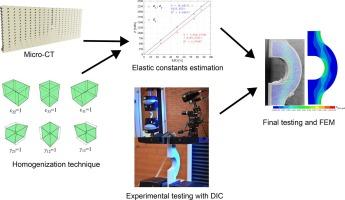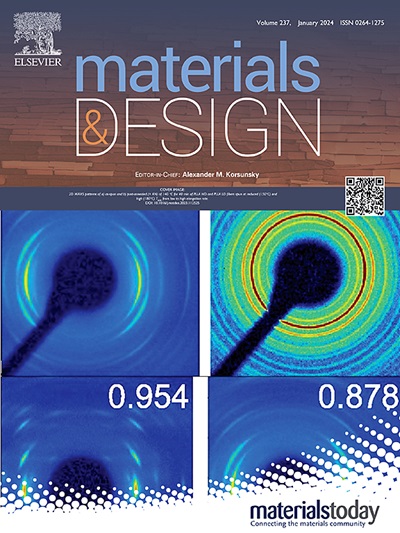Estimation and validation of elastic constants in fused filament fabrication 3D printing: From mesoscale to macroscale
IF 7.6
2区 材料科学
Q1 MATERIALS SCIENCE, MULTIDISCIPLINARY
引用次数: 0
Abstract
Evaluating the mechanical properties of 3D-printed parts is a cumbersome task. This study poses an approach based on computational homogenization to estimate the elastic constants of fused filament fabrication 3D-printed parts. A whole methodology for characterization and experimental validation is necessary to improve finite element numerical models.
Samples are characterized both mechanically and geometrically. To improve the characterization, novel algorithms based on micro-computed tomography images and image segmentation techniques are implemented. Thereafter, elastic constants are estimated, informed by the characterization results. The method’s effectiveness is assessed through a deep comparison, based on the digital image correlation technique, between different experimental samples and finite element models.
Results show that the numerical estimation provided in this work is accurate enough to develop realistic finite element models, including anisotropy of the structures. However, defects and voids developed during 3D printing are an important source of error for these numerical models.
This work provides an estimation and validation of elastic constants in 3D-printed parts, including geometrical characterization, numerical homogenization and experimental validation. The results of this work provide valuable information encompassing techniques to improve the characterization of 3D-printed parts, tendencies on elastic constants, and main sources of error.

熔丝制造三维打印中弹性常数的估算和验证:从中观尺度到宏观尺度
评估 3D 打印部件的机械性能是一项繁琐的任务。本研究提出了一种基于计算均质化的方法,用于估算熔融长丝制造三维打印部件的弹性常数。要改进有限元数值模型,就必须有一套完整的表征和实验验证方法。为了改进表征,采用了基于微型计算机断层扫描图像和图像分割技术的新型算法。之后,根据表征结果估算弹性常数。结果表明,这项工作提供的数值估算足够精确,足以开发出逼真的有限元模型,包括结构的各向异性。然而,三维打印过程中产生的缺陷和空隙是这些数值模型的重要误差来源。这项工作提供了三维打印部件弹性常数的估算和验证,包括几何特征描述、数值同质化和实验验证。这项工作的结果提供了有价值的信息,包括改进三维打印部件表征的技术、弹性常数的趋势和主要误差来源。
本文章由计算机程序翻译,如有差异,请以英文原文为准。
求助全文
约1分钟内获得全文
求助全文
来源期刊

Materials & Design
Engineering-Mechanical Engineering
CiteScore
14.30
自引率
7.10%
发文量
1028
审稿时长
85 days
期刊介绍:
Materials and Design is a multi-disciplinary journal that publishes original research reports, review articles, and express communications. The journal focuses on studying the structure and properties of inorganic and organic materials, advancements in synthesis, processing, characterization, and testing, the design of materials and engineering systems, and their applications in technology. It aims to bring together various aspects of materials science, engineering, physics, and chemistry.
The journal explores themes ranging from materials to design and aims to reveal the connections between natural and artificial materials, as well as experiment and modeling. Manuscripts submitted to Materials and Design should contain elements of discovery and surprise, as they often contribute new insights into the architecture and function of matter.
 求助内容:
求助内容: 应助结果提醒方式:
应助结果提醒方式:


